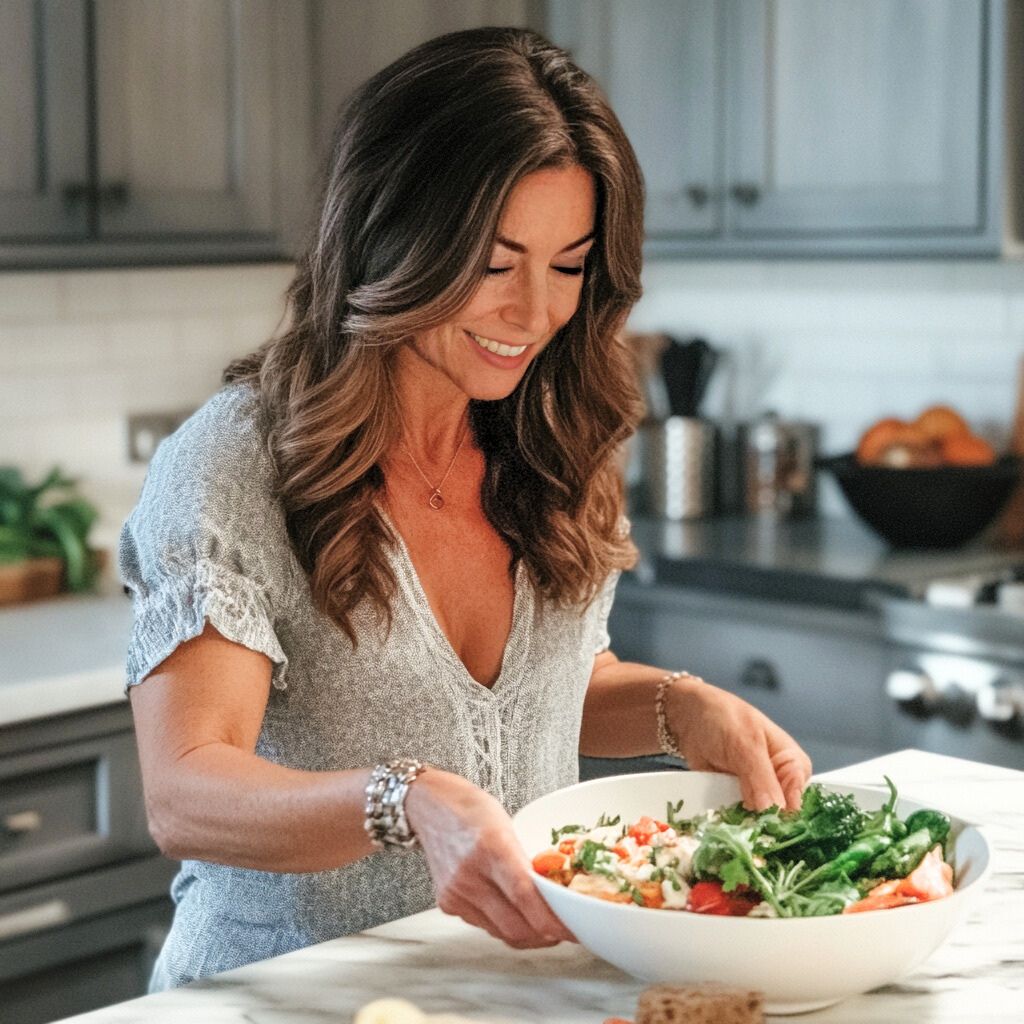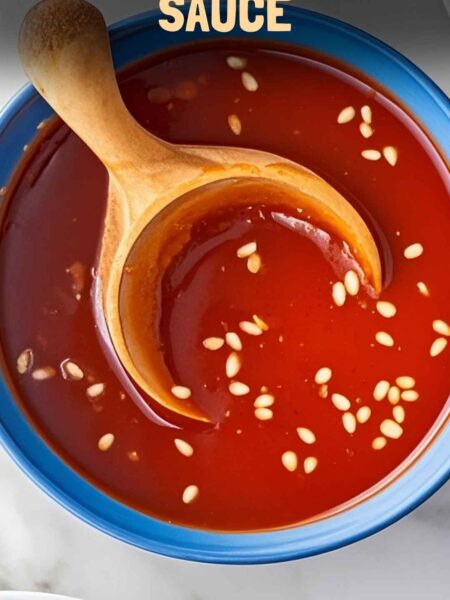Thai Curried Butternut Squash Soup pairs beautifully with crusty bread like baguette or sourdough. The crunchy crust and soft interior are perfect for scooping up the creamy soup. This combo adds satisfying texture and comfort.
A crisp green salad with tangy vinaigrette adds freshness and balance. Ingredients like cucumber, cherry tomatoes, and avocado bring cool contrast to the warm soup. It lightens the meal and adds vibrant flavors.
Grilled shrimp marinated in lime and garlic elevates the dish with savory, zesty protein. Jasmine or brown rice makes the meal heartier, soaking up the soup’s rich flavors. Thai spring rolls add a crunchy, refreshing side perfect for dipping.

What is Thai Curried Butternut Squash Soup?
Thai Curried Butternut Squash Soup combines the natural sweetness of butternut squash with classic Thai flavors. The soup is typically creamy, thanks to the addition of coconut milk or cream, and contains spices that offer a delightful heat and depth.
Thai red curry paste brings that signature kick, while ginger and lemongrass round it out with freshness and zing.
This dish is not just another pumpkin soup; it’s a blend of textures and flavors that reflect a blend of culinary cultures. A comforting dish yet exciting—it’s the kind that warms you up during chilly nights or serves well at gatherings.
What Makes This Recipe Different from Other Thai Curried Butternut Squash Soup?
Many recipes for Thai curried butternut squash soup stick to familiar ingredients. This version stands out due to a few key elements:
- Fresh Ingredients: Using fresh ginger and lemongrass elevates the flavor profile considerably.
- Coconut Cream Drizzle: Adding coconut cream not just for cooking but also for drizzling adds richness.
- Spices: The unique blend of coriander and cumin enhances the depth, making it memorable.
When you prepare this soup, you’ll discover that it’s more than just blending ingredients together. It’s about layering flavors and respecting the ingredients’ natural attributes.
How Does It Taste?
When I took my first spoonful, it was a delightful explosion of flavors. The sweetness of the butternut squash balanced perfectly with the heat of the curry paste, and the coconut cream added a rich creaminess. The spices danced around, creating a warm, inviting sensation. You receive a hint of citrus from the lime juice, adding brightness to the experience.
Vibrant flavor envelops you with each sip. The slight kick from the chili flakes gives it just enough zing without overwhelming the delicate sweetness of the squash. The texture is silky smooth, making it ideal for sipping or savoring with a piece of bread.
Ingredients You’ll Need to Make This Dish
To recreate this flavorful dish, gather the following ingredients:
- 4 cups rich vegetable stock
- 2 pounds peeled, seeded, and diced butternut or kabocha squash (cut into ½-inch cubes)
- 2 tablespoons extra virgin coconut oil or cold-pressed olive oil
- 1 medium yellow onion, finely chopped
- 4 garlic cloves, minced or crushed
- 2 to 3 tablespoons Thai red curry paste
- 2 teaspoons ground coriander seeds
- 1 teaspoon ground cumin powder
- ¼ teaspoon fine sea salt
- ⅛ teaspoon crushed red chili flakes
- 1 teaspoon freshly grated ginger
- 1 small lemongrass stalk, finely minced
- 1 tablespoon freshly squeezed lime juice
- ½ cup full-fat coconut cream, for drizzling
- ½ cup large unsweetened toasted coconut flakes
- A handful of freshly chopped cilantro leaves
This array of ingredients is simple yet transformative.

Step-by-Step Instructions
Cooking Thai Curried Butternut Squash Soup is simple. Let’s break it down step by step.
Step 1: Prepare the Butternut Squash
Start by peeling and cubing your butternut squash. Aim for about ½-inch cubes for even cooking. If you run into trouble peeling, use a sturdy peeler or a knife; just exercise caution.
Step 2: Cook the Aromatics
In a large pot, heat the coconut oil over medium heat. Add the chopped onion and sauté until translucent. This usually takes about 5 minutes. Next, toss in the minced garlic, ginger, and lemongrass, cooking for another 2 minutes until fragrant.
Step 3: Add the Spices
Stir in the Thai red curry paste, ground coriander, cumin, salt, and chili flakes. Allow the spices to cook for about a minute. The goal here is to release their essential oils, creating a robust flavor.
Step 4: Incorporate the Squash and Stock
Once your spices are aromatic and lively, add the diced butternut squash and pour in the vegetable stock. Give it a good stir and bring the mixture to a gentle simmer. Cover the pot, reduce the heat, and let it simmer for 20-25 minutes, or until the squash is tender.
Step 5: Blend the Mixture
After the squash has softened, remove from heat and let it cool for a few minutes. Using a blender (or an immersion blender), carefully blend the soup until it’s smooth and creamy.
Step 6: Add Creaminess
Return the blended soup to the pot. Stir in the freshly squeezed lime juice and taste. Adjust seasoning as necessary. For added creaminess, drizzle in the coconut cream and mix well.
Step 7: Serve and Garnish
Ladle the soup into bowls. Top with toasted coconut flakes and freshly chopped cilantro for garnish. Serve it alongside your chosen sides.
Tips & Tricks on Making Thai Curried Butternut Squash Soup
- Opt for Fresh Herbs: Fresh cilantro adds a nice punch. Dried herbs won’t offer the same effect.
- Control the Heat: Adjust the amount of red curry paste based on your heat tolerance. Start with less and add more gradually.
- Preserve the Color: When blending, blend in batches if necessary to avoid overfilling the blender.
- Coconut Milk Alternative: For a lighter version, consider using light coconut milk instead of coconut cream.
- Add Texture: For variety, toss in some crispy chickpeas or nuts as a topping. It adds crunch.
How Do I Store This Dish?
If you have leftovers (or if you’re smart and make extra), storing this soup is easy. Allow it to cool completely, then transfer it to an airtight container.
It will last in the fridge for 4-5 days. You can also freeze it. Just ensure you leave space for expansion. It can last in the freezer for up to 3 months.
What Other Substitutes Can You Use in Thai Curried Butternut Squash Soup?
If you want to get creative or are missing some ingredients, there are alternatives:
- Sweet Potatoes: Boldly utilize sweet potatoes in place of butternut squash. They add a different sweetness while maintaining the creamy texture.
- Carrots: Substituting half the squash with carrots gives an intricate flavor.
- Pumpkin: Using pumpkin puree is a tasty swap but ensure it’s the natural kind, not the spiced, canned version.
- Vegetable Broth: If stock is not available, high-quality vegetable broth works wonders. It keeps the flavor intact.
- Soy Milk: For vegans or those avoiding coconut, subsisting with soy or almond milk provides a lighter texture, though it changes the flavor profile a bit.

Conclusion
Thai Curried Butternut Squash Soup is much more than just a simple dish. It offers warmth, comfort, and an explosion of flavors.
This recipe transforms humble ingredients into something unforgettable. With a straightforward approach to cooking and a few tricks, you can impress yourself and your guests.
Next time you’re feeling creative in the kitchen or hosting, give this a try. Trust me; you’ll be taking seconds and maybe even thirds. Enjoy your cooking adventure!
You’ll also like the following recipes!
- Simple Delicious Coconut Curry
- Whole Grain Seeded Bread Recipe
- The Best Damn Vegan Mashed Potatoes Recipe
Thai Curried Butternut Squash Soup – Affordable Food Ideas
I first stumbled upon Thai Curried Butternut Squash Soup during a cozy dinner party at a friend’s house. As the aroma wafted through the living room, I couldn't help but feel curiosity bubbling inside.
The vibrant orange hue hinted at something special. Little did I know this dish would become a regular feature in my kitchen. Why? It's warming, creamy, and packed with flavors that dance on the palate. Let’s explore this delightful recipe together.

Ingredients
Instructions
Step 1: Prepare the Butternut Squash
-
Start by peeling and cubing your butternut squash. Aim for about ½-inch cubes for even cooking. If you run into trouble peeling, use a sturdy peeler or a knife; just exercise caution.
Step 2: Cook the Aromatics
-
In a large pot, heat the coconut oil over medium heat. Add the chopped onion and sauté until translucent. This usually takes about 5 minutes. Next, toss in the minced garlic, ginger, and lemongrass, cooking for another 2 minutes until fragrant.
Step 3: Add the Spices
-
Stir in the Thai red curry paste, ground coriander, cumin, salt, and chili flakes. Allow the spices to cook for about a minute. The goal here is to release their essential oils, creating a robust flavor.
Step 4: Incorporate the Squash and Stock
-
Once your spices are aromatic and lively, add the diced butternut squash and pour in the vegetable stock. Give it a good stir and bring the mixture to a gentle simmer. Cover the pot, reduce the heat, and let it simmer for 20-25 minutes, or until the squash is tender.
Step 5: Blend the Mixture
-
After the squash has softened, remove from heat and let it cool for a few minutes. Using a blender (or an immersion blender), carefully blend the soup until it’s smooth and creamy.
Step 6: Add Creaminess
-
Return the blended soup to the pot. Stir in the freshly squeezed lime juice and taste. Adjust seasoning as necessary. For added creaminess, drizzle in the coconut cream and mix well.
Step 7: Serve and Garnish
-
Ladle the soup into bowls. Top with toasted coconut flakes and freshly chopped cilantro for garnish. Serve it alongside your chosen sides.
Nutrition Facts
Servings 6
- Amount Per Serving
- Calories 160kcal
- % Daily Value *
- Total Fat 7.1g11%
- Saturated Fat 5.9g30%
- Sodium 126mg6%
- Total Carbohydrate 25g9%
- Dietary Fiber 5g20%
- Sugars 7g
- Protein 2g4%
* Percent Daily Values are based on a 2,000 calorie diet. Your daily value may be higher or lower depending on your calorie needs.
Note
- Opt for Fresh Herbs: Fresh cilantro adds a nice punch. Dried herbs won’t offer the same effect.
- Control the Heat: Adjust the amount of red curry paste based on your heat tolerance. Start with less and add more gradually.
- Preserve the Color: When blending, blend in batches if necessary to avoid overfilling the blender.
- Coconut Milk Alternative: For a lighter version, consider using light coconut milk instead of coconut cream.
- Add Texture: For variety, toss in some crispy chickpeas or nuts as a topping. It adds crunch.




